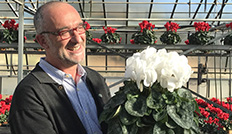 Professional area | Culture factsheet | Light and temperature | The effect of temperature
Professional area | Culture factsheet | Light and temperature | The effect of temperature
In the DIF (daytime/night-time temperature difference) system, used especially in northern Europe, temperatures are linked directly with the quantity of light; this also enables compact plants to be produced.
Light and warmth act together on plants; they influence particularly the look of the plant, the formation of flowers and the length of the growing period: and this applies at all phases. Flower formation depends more on light than on temperature, while the full development of flowers and the second growth of leaves is mainly governed by temperature.
Temperature has a considerable effect on the stage of germination (18ºC), flower formation and the overall length of the growing cycle.
It should be borne in mind, though, that different varieties can behave differently as far as their temperature and light requirements are concerned; so vigilance is needed.
For each stage of growth and development to take place as it should, it is essential to keep temperatures to their appropriate value. This is what guarantees that the plants will develop well and reach the desired quality; and it should be remembered that constant temperatures do much to ward off attacks of fungal disease such as Botrytis.
During the growth phase it would appear that night temperatures have a less pronounced effect than daytime ones. However, various studies have shown that if daytime temperatures are kept below night-time ones it is possible to get more compact plants with shorter stalks to the leaves and flowers. This would be a worthwhile practice when small plants, or plants of a good compact habit, are required. By contrast, keeping daytime temperatures above night-time ones produces plants with leaf and flower stalks considerably longer than when temperatures are kept even (at equivalent average temperatures). The plant’s parts are also softer; leaves are larger and the flowers are paler. Finally, although a higher daytime temperature does allow a shorter growing season, the quality of the plants also goes down.
With the help of heating systems it is relatively easy to control the temperature, especially at times of year when outside temperatures are not too high. In summer, though, it is sometimes a difficult business to keep temperatures ideal for the plants, for the ideal temperature is often lower than those prevailing outside.
2565, rue de Montourey
83600 Fréjus - France
International telephone : +33 (0)4 94 19 73 04
Switchboard : + 33 (0)4 94 19 73 00
Fax : +33 (0)4 94 19 73 19

